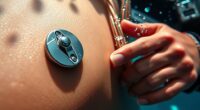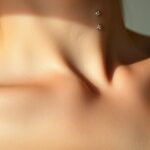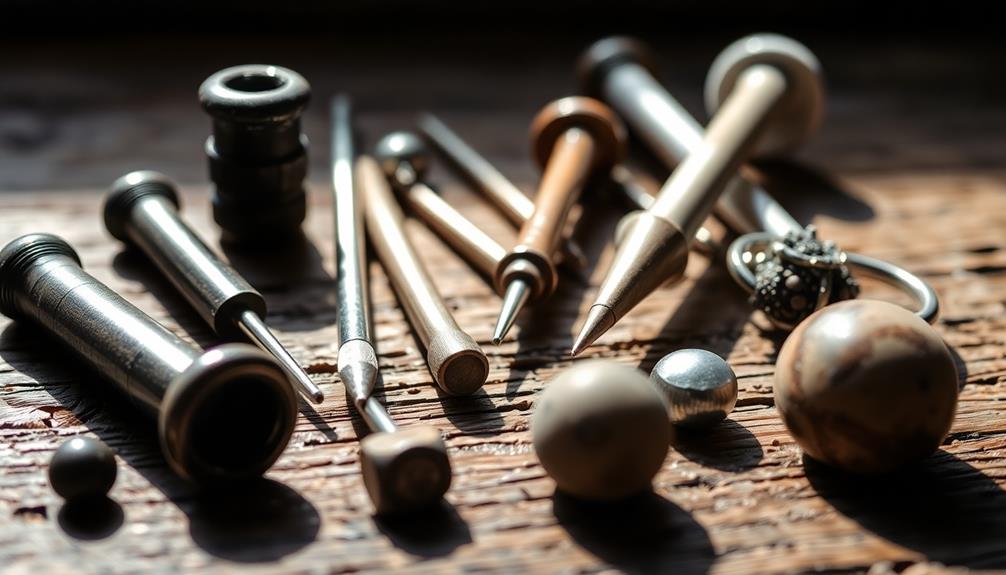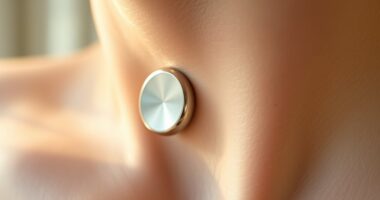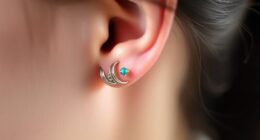Microdermal and dermal anchors are tiny implants placed underneath your skin to hold body jewelry securely. The process involves making a small incision, creating a pocket, and inserting the anchor so it sits flush with your skin. Proper placement is vital for safety, aesthetics, and long-term wear. Healing typically takes weeks to months, with aftercare essential for success. Want to learn more about how these anchors work and their placement techniques? Keep exploring to find out!
Key Takeaways
- Microdermal and dermal anchors are small implants embedded beneath the skin to support surface jewelry.
- Proper placement involves precise incision, creating a pocket, and secure insertion to prevent migration.
- The healing process typically takes weeks to months, requiring diligent aftercare and hygiene.
- Correct placement ensures stability, reduces rejection risk, and enhances aesthetic appearance.
- Skilled professionals are essential for safe placement, minimizing complications and ensuring long-lasting results.
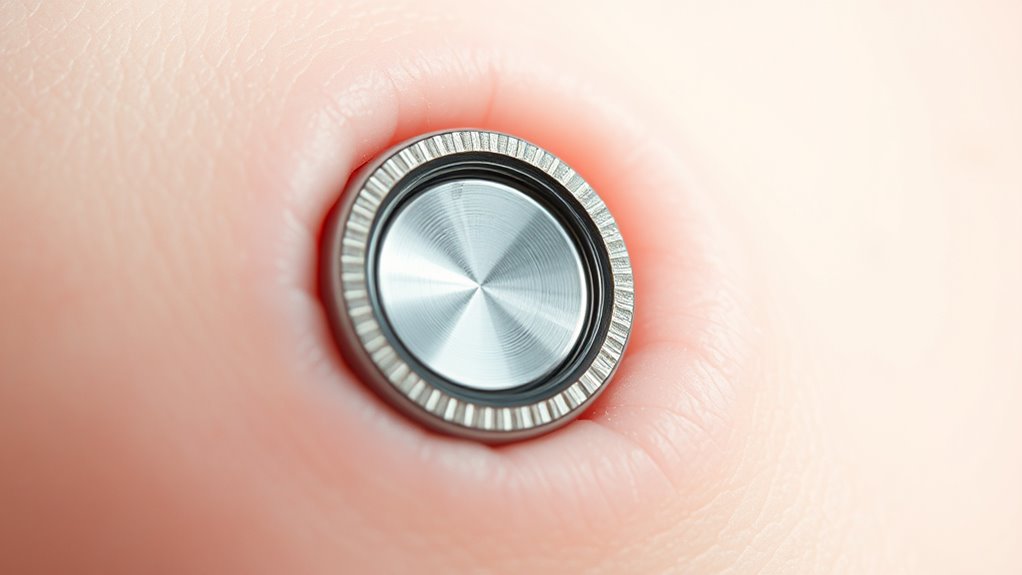
Have you ever wondered how microdermal and dermal anchors are used to create unique body jewelry? These tiny, versatile implants are revolutionizing body modification by allowing you to wear jewelry in almost any part of your body. The process begins with understanding how these anchors are placed beneath your skin and how they heal afterward. The healing process is essential to ensure the implant stays secure and your body recovers without complications. Proper placement techniques are indispensable for both aesthetic appeal and safety, so knowing what to expect can help you make informed decisions.
When it comes to placement techniques, your piercer will first assess the area where you want the anchor. They’ll mark the spot carefully, considering your anatomy and the type of jewelry you desire. The actual insertion involves making a small incision or punch, then creating a precise pocket beneath the skin. The microdermal or dermal anchor is then inserted into this pocket, with the top part left exposed for jewelry attachment. This process requires skill to guarantee the anchor sits flush with the skin and is securely anchored. A well-executed placement reduces the risk of migration or rejection, which are common concerns with these implants.
The healing process varies depending on the location and your body’s response. Generally, it takes a few weeks to a few months for the area to fully heal. During this time, you’ll need to follow specific aftercare instructions to prevent infection and promote proper integration of the implant. This includes keeping the area clean, avoiding unnecessary movement that could disrupt the healing, and monitoring for signs of swelling or irritation. Your piercer might recommend using antiseptic solutions and avoiding submersion in water until fully healed. Proper aftercare directly impacts the healing process, helping to minimize complications and ensuring your new body jewelry remains in place securely.
Placement techniques are also designed to minimize discomfort and guarantee the anchor’s stability. Your piercer might use local anesthesia or numbing agents to make the process more comfortable. They’ll also ensure the implant is positioned at the correct depth to avoid protrusion or migration. Choosing an experienced professional is indispensable because improper placement can lead to rejection or uneven healing. With the right technique and diligent aftercare, microdermal and dermal anchors can provide a durable and eye-catching way to express your personal style. Ultimately, understanding these aspects will help you enjoy your body modification safely and confidently.
Frequently Asked Questions
How Long Does a Microdermal or Dermal Anchor Procedure Typically Take?
The procedure duration for a microdermal or dermal anchor usually takes about 30 to 60 minutes. You should plan on clinic scheduling accordingly, as this allows enough time for numbing, placement, and aftercare instructions. Keep in mind that individual cases vary, so it’s best to consult your specialist beforehand. With proper planning, you’ll experience a smooth procedure and minimal downtime.
Are There Any Specific Aftercare Instructions Unique to Microdermal Implants?
Think of your microdermal implant like a delicate garden plant; it needs proper care to thrive. You should keep the area clean, avoid touching or twisting it, and follow your practitioner’s instructions for cleaning and ointments. During the healing process, watch for signs of infection like redness or swelling. Prevent infection by keeping the site dry and avoiding irritants, ensuring your new piercing stays healthy and looks great.
Can Microdermal Anchors Be Safely Removed or Relocated Later?
Yes, you can safely remove or relocate microdermal anchors later. Anchor removal is usually straightforward and performed by a professional to guarantee proper healing. Relocation safety depends on healing time and tissue condition, so it’s best to consult your piercer or dermatologist. They’ll assess your skin’s health and guide you through the process, minimizing risks and guaranteeing a smooth transition if you decide to change the placement.
What Are the Common Risks or Complications Associated With These Implants?
You might encounter infection risks or implant rejection with microdermal and dermal anchors. Infection can happen if proper aftercare isn’t observed, leading to swelling, redness, or pus. Rejection occurs when your body perceives the implant as foreign, causing it to push the anchor out. To minimize these risks, guarantee your procedure is done by a professional, follow all aftercare instructions, and monitor for signs of complications.
How Do I Choose the Right Professional for My Microdermal or Dermal Anchor Placement?
When choosing a professional for your microdermal or dermal anchor placement, look for someone with proper professional certification to guarantee they meet safety standards. Review their portfolio to check their experience and quality of work. Ask for before-and-after photos, and read reviews from previous clients. Trust a specialist who demonstrates expertise, cleanliness, and professionalism, ensuring your procedure is safe and results meet your expectations.
Conclusion
Now that you understand microdermal and dermal anchors, you’re like an artist wielding a delicate brush, ready to craft your unique masterpiece on your skin’s canvas. These tiny anchors are the silent architects of your self-expression, holding your chosen jewelry like secret treasures waiting to be revealed. Approach them with respect and care, and they’ll become a part of your story—an intricate thread woven into the vibrant tapestry of your individuality.


